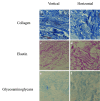Comprehensive Quantification of Collagen, Elastin, and Glycosaminoglycans in the Human Facial Dermis: Insights From a Pilot Study
- PMID: 40296941
- PMCID: PMC12036737
- DOI: 10.7759/cureus.81419
Comprehensive Quantification of Collagen, Elastin, and Glycosaminoglycans in the Human Facial Dermis: Insights From a Pilot Study
Abstract
Background Age-related alterations in the dermal extracellular matrix (ECM) drive skin aging and are linked to numerous dermatological conditions, including diminished wound healing and compromised skin integrity. Our study aims to quantify and compare the distribution of collagen, elastic fibers, and glycosaminoglycans (GAGs) across different ages and analyze their patterns in vertical sections of the facial dermis. Methods Skin samples were collected from the under-eye (UE) and forehead (FH) regions of 24 male and female human cadavers aged 59-87. Samples were processed histologically. Collagen, elastic fibers, and GAG content were stained using trichrome, van Gieson, and alcian blue stains, respectively. The data was collected using ImageJ software. Two-way ANOVA with post hoc Tukey's test was used to analyze differences across regions and stain types. Results The FH region showed significantly higher GAGs in horizontal sections compared to vertical (p < 0.0001), with no significant differences in collagen (p = 0.9968) or elastic fibers (p = 0.8762). In the UE region, GAGs were also higher in horizontal sections (p = 0.0001), while collagen (p = 0.3954) and elastic fibers (p > 0.9999) showed no differences. Comparing FH and UE, vertical sections showed significant differences in collagen (p = 0.021) and GAGs (p = 0.0027), with higher values in FH. Horizontal sections showed significantly higher GAGs in FH (p = 0.001), with no differences in collagen (p = 0.5709) or elastic fibers (p > 0.9999). ECM changes were significant with age, but no differences were observed based on gender. Conclusions These findings offer novel insights into the structural and functional differences in the facial dermis, which can inform targeted anti-aging treatments, improve strategies for wound healing, and guide personalized dermatological interventions for skin integrity and rejuvenation.
Keywords: collagen-elastin matrix; dermal extracellular matrix; dermatology; glycosaminoglycans; skin repair.
Copyright © 2025, Bouchelkia et al.
Conflict of interest statement
Human subjects: All authors have confirmed that this study did not involve human participants or tissue. Animal subjects: All authors have confirmed that this study did not involve animal subjects or tissue. Conflicts of interest: In compliance with the ICMJE uniform disclosure form, all authors declare the following: Payment/services info: All authors have declared that no financial support was received from any organization for the submitted work. Financial relationships: All authors have declared that they have no financial relationships at present or within the previous three years with any organizations that might have an interest in the submitted work. Other relationships: All authors have declared that there are no other relationships or activities that could appear to have influenced the submitted work.
Figures


References
-
- A guide to the composition and functions of the extracellular matrix. Karamanos NK, Theocharis AD, Piperigkou Z, et al. FEBS J. 2021;288:6850–6912. - PubMed
-
- Varma RS, Varma R. Glycosaminoglycans and Proteoglycans in Physiological and Pathological Processes of Body Systems. Karger Publishers; 1982. Glycosaminoglycans and proteoglycans of skin; pp. 151–164.
LinkOut - more resources
Full Text Sources
Miscellaneous
